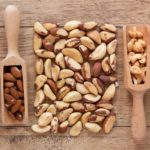
Tiana Hape-Cramond
Associate Registered Nutritionist
Amino acids are essential for our health and are used for important functions such as building muscle, hormones, neurotransmitters and overall growth and repair.
Amino acids can be obtained through diet, from either plant-based or animal sources, and are categorized in three groups:
- Essential amino acids
- Non-essential amino acids
- Conditionally essential amino acids
To get a better understanding of amino acids and their function, first we have to understand what an amino acid is, which we explain in our next section.
What are Amino Acids?
There are 20 amino acids
They are classified in 3 groups:
- essential amino acids (9)
- non-essential amino acids (11)
- conditional amino acids (7)
The body uses amino acids to make proteins that help to break down food, grow and repair body tissue and perform other body functions.
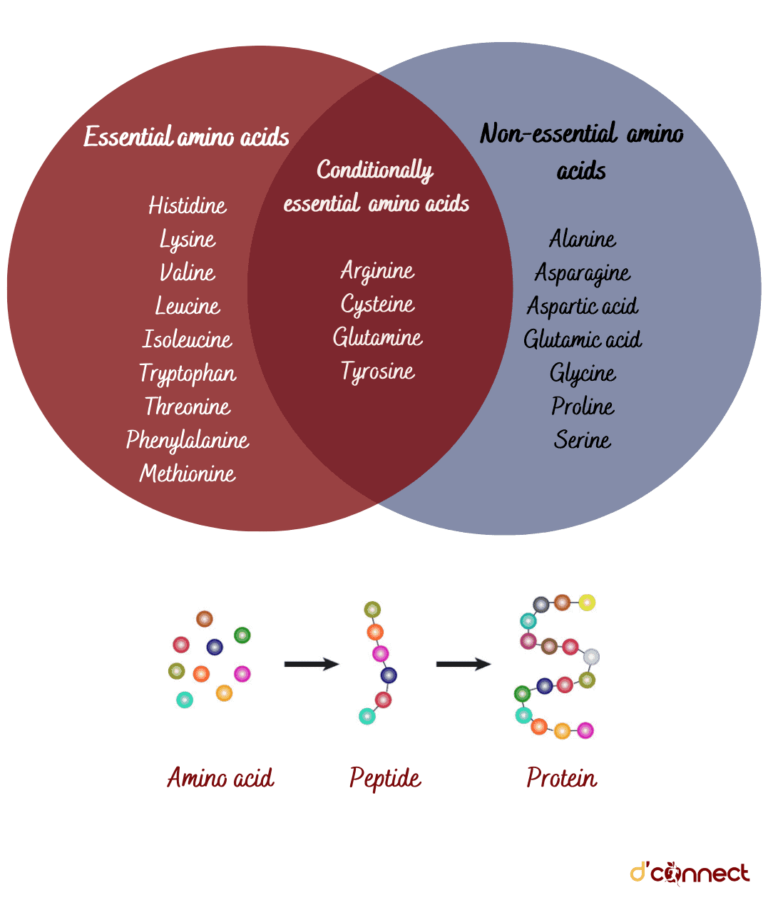
There are two more amino acids Selenocysteine and Pyrrolysine that should be mentioned.
Selenocysteine is the only amino acid to contain selenium and is used for cellular processes. Selenocysteine is not as abundant in plants and bacteria and is therefore not categorized with the other amino acids.
Pyrrolysine is an amino acid used for protein synthesis in some bacteria but is not present in humans.
Essential amino acids
Essential amino acids can not be made by the body, which means that we must obtain them from food sources.
Phenylalanine
Phenylalanine is key for the synthesis of other amino acids and is important for proteins and enzymes.
For example, phenylalanine can be converted to tyrosine which is used to make the neurotransmitters dopamine and norepinephrine.
Sources of phenylalanine include animal foods
- meat (beef, pork, lamb, venison)
- poultry (chicken, duck, goose, turkey)
- eggs
- dairy (milk, cheese, yogurt)
and non-animal foods such as
- oats
- quinoa
- lentils
- nuts (almonds, pistachios, macadamia nuts, cashews, walnuts)
- seeds (pumpkin seeds, squash seeds, hemp seeds, sunflower seeds.[3]
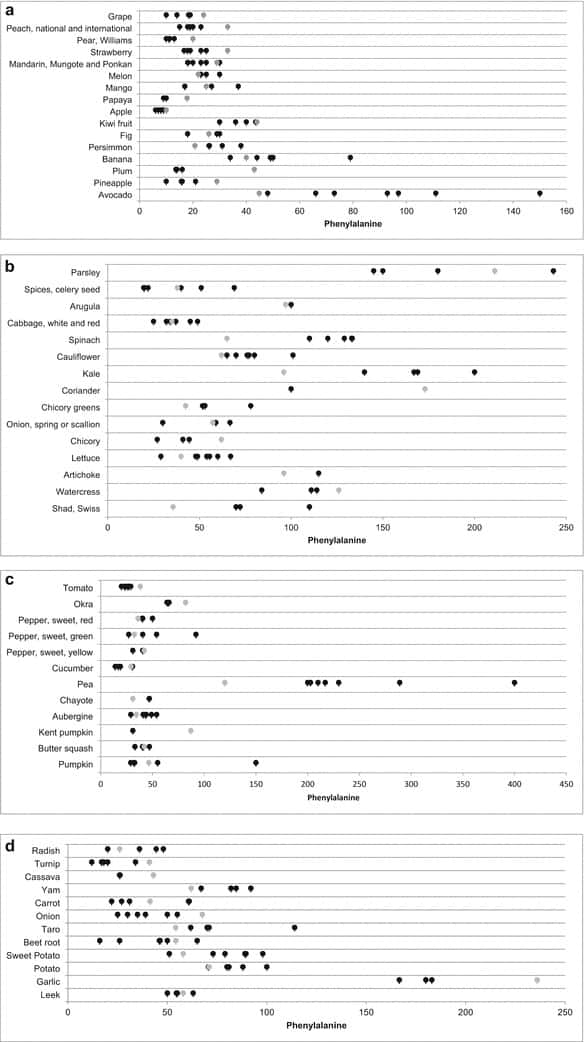
Source: Akutsu, R. Table of Phenylalanine Content of Foods: Comparative Analysis of Data Compiled in Food Composition Tables. (2016)
Valine
Valine is one of the three branched-chain amino acids. It has an important function in muscle growth and regeneration and is involved in energy production.
It can be found in animal sources
- meat (beef, pork, lamb, venison)
- dairy (milk, cheese, yogurt)
and non-animal sources such as
- wholegrains (wheat, barley, oats, rice)
- soy
- nuts (almonds, walnuts, peanuts, pine nuts, hazelnuts)
- vegetables (cauliflower, zucchini, capsicum, cucumber, onions, cabbage, spinach).[4]
Tryptophan
Tryptophan is an amino acid that is essential for normal growth in infants and production of proteins, enzymes and neurotransmitters.
Tryptophan is used to make melatonin which regulates
the sleep-wake cycle
Sources of tryptophan include animal foods
- meat (beef, pork)
- poultry (chicken, turkey)
- egg whites
- dairy (milk, yogurt, cheese)
and non-animal foods such as
- sunflower seeds
- sesame seeds
- soybeans.[5]
Threonine
Threonine is an essential amino acid used for important proteins like tooth enamel, collagen and elastin.
It is also used in the nervous system, and prevents fat buildup in the liver.[6]
Threonine can be found in animal sources
- meat (lean beef, lamb, pork)
- dairy (milk, cheese, yogurt)
and non-animal sources such as
- soy
- sunflower seeds
- nuts (cashews and almonds)
- flaxseeds.[7]
Isoleucine
Isoleucine is a branched-chain amino acid that is vital for growth, immune function, hemoglobin production, energy regulation, glucose transportation and muscle metabolism.
Sources of isoleucine include animal foods
- meat (beef, pork)
- poultry (chicken)
- fish (tuna, cod)
- dairy (cheese, milk)
and non-animal foods such as
- peas
- oats
- lentils
- spirulina
- sunflower
- sesame seeds.[7]
Methionine
This essential amino acid is used to help the breakdown of fats and may prevent fat build up in the liver.[8]
Methionine contains sulfur which acts as an antioxidant for the body and protects cells from free radical damage.
Methionine can be found in animal sources
- meat (lean beef, lamb, buffalo)
- poultry (turkey, chicken)
- fish (salmon, snapper, mahi)
- dairy (cheese, yogurt)
and non-animal sources such as
- soy
- nuts (brazil nuts)
- beans
- lentils.[7]

Histidine
Histidine is used to create histamine
Histamine is vital for digestion, sexual function, sleep-wake cycles and immune response.[9]
Sources of histidine include animal foods
- meat (beef, lamb, pork)
- fish (tuna)
- poultry (chicken)
and non-animal foods such as
- tofu
- pumpkin seeds
- fruit (apples, pomegranates)
- vegetables (beets, carrots, cucumber, garlic, spinach).[7]
Leucine
Leucine is used for protein synthesis, muscle repair and wound healing, and it helps to regulate blood sugar levels.
Also, it has a role in stimulating growth hormones.[10]
Leucine can be found in animal foods
- meat (beef, lamb, pork)
- poultry (chicken, turkey, goose)
- fish (tuna, grouper)
- dairy (cheese)
and non-animal foods such as
- brown rice
- quinoa
- sunflower seeds
- nuts (peanuts)
- corn
- spirulina.[7]
Lysine
Lysine is important for muscle repair and growth, producing hormones, enzymes and antibodies.
It is also used to aid absorption of iron, zinc and calcium which are important minerals for immune health.[11] Source with the highest amount of lysine is red meat.
Non-animal sources include
- avocado
- lima beans
- dried apricots
- leeks
- potatoes.[7]
Nonessential amino acids
Non-essential amino acids are also found in foods but can be made by our body.
Non-essential amino acids can be made during metabolic processes such as converting food into energy. Another way the body makes non-essential amino acids is using essential amino acids. For example, phenylalanine is the precursor for the non-essential amino acid tyrosine.
Alanine
Alanine is a non-essential amino acid that is used to break down tryptophan and vitamin B6.
Alanine is important for creating energy in the muscles and central nervous system and strengthening the immune system.[12]

Source: Boccanegra, B. BCAAs and Di-Alanine supplementation in the prevention of skeletal muscle atrophy: preclinical evaluation in a murine model of hind limb unloading. (2021)
Alanine can be found in
- meat (lamb, beef, pork)
- poultry (chicken, turkey)
- fish (hake, conger)
- eggs
- dairy (cheese, yogurt)
Some non-animal sources of alanine include
- spinach
- watercress
- soy
- cauliflower
- nuts (peanuts)
- sunflower seeds.[13]
Arginine
Arginine has a function in growth and has been indicated as crucial for wound healing, especially in those with poor circulation.[14]
As proteins are digested, arginine is converted into nitric oxide. Nitric oxide is known to help with decreasing blood pressure.
Arginine can be found in animal sources
- meat (red meat)
- poultry (chicken, turkey)
and non-animal sources such as
- nuts (almonds, cashews)
- seeds (pumpkin seeds)
- wholegrains (brown rice, oats)
- legumes (soybeans, chickpeas).
Asparagine
Asparagine is similar to aspartic acid and has an important role in creating proteins that are required by the body.
Asparagine is also used in the urea cycle which removes toxic ammonia from the body.[15]
Asparagine rich foods include
- meat (beef, pork, veal)
- fish (salmon, mackerel)
- eggs
- dairy (whey, cheese, milk, yogurt)
and non-animal sources such as
- legumes
- wholegrains (brown rice, oats).[16]
Aspartic acid
Aspartic acid is important for the synthesis of other amino acids including asparagine, arginine, lysine, methionine, isoleucine and some nucleotides.
This non-essential amino acid plays a role in the citric acid cycle which is important for energy production and urea cycle which eliminates toxic ammonia from the body.[17]
Sources of aspartic acid include animal foods
- meat (beef, lamb, pork)
- poultry (chicken, turkey)
- fish (tuna, grouper, salmon, oysters)
- eggs
and non-animal foods such as
- asparagus
- avocado
- nectarines.[18]
Cysteine
Cysteine is an amino acid that is converted into glutathione which is known to be a powerful antioxidant.
RELATED — N-Acetyl Cysteine (NAC)
Cysteine is important for regular growth and may affect aging of the skin because of its role in producing collagen.[19]
Cysteine is vital for creating glutathione
Antioxidants like glutathione protect cells from free radicals which some researchers think play a role in aging well, development of health problems such as cancer and heart disease.
Sources of cysteine include animal foods
- meat (pork, beef)
- poultry (chicken, turkey)
- fish (tuna, salmon, shellfish)
- eggs
- dairy (cheese, yogurt)
and non-animal foods such as
- oats
- lentils
- sunflower seeds.[20]
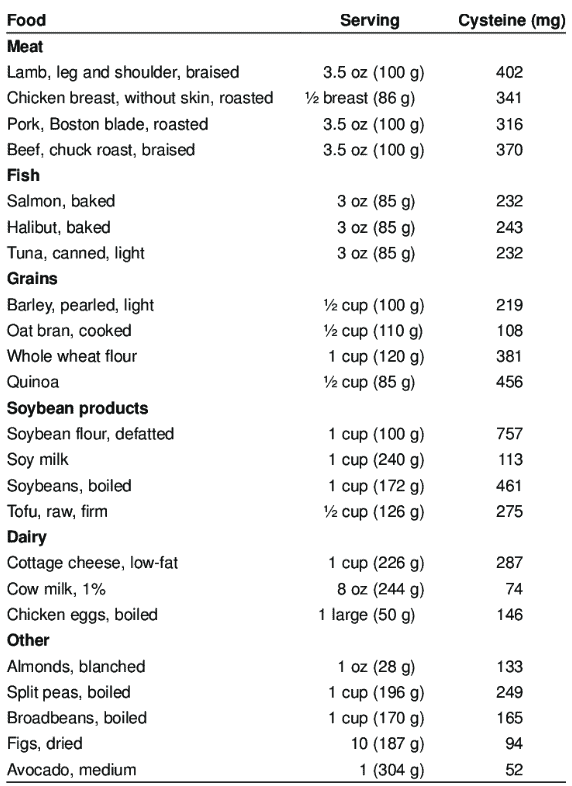
Source: Vasdev, S. The antihypertensive effect of cysteine. (2009)
Glutamic acid
Glutamic acid is converted to glutamate, which helps nerve cells to send and receive signals.[21]
Functions of glutamic acid include
- Cellular metabolism – glutamate disposes excess nitrogen
- Brain function – glutamate provides energy for the brain
- Prostate health – glutamate supports the healthy functioning of prostate
- Immune system – glutamate removes toxic metabolic waste products that are created by the body.[22]
Most glutamic acid is consumed through eating
- meat (beef, lamb)
- poultry (chicken, turkey)
- fish (tuna, sea bass)
- dairy (milk)[23]
Non-animal sources of glutamic acid include
- tomatoes
- green peas
- mushrooms.[24]
Glutamine
Glutamine is the most abundant amino acid in the body and is used for removing excess ammonia, helping with immune function and may be needed for normal brain function and digestion.[25]
However, during times of extreme stress, such as strenuous exercise or injury, the body may require more. This is the reason it is considered a conditional amino acid.
Most of glutamine is stored in the muscles and is used for removing excess ammonia, assisting immune function, and may also be needed for brain function and digestion.
Glutamine can be found in animal sources
- meat (beef)
- eggs
- dairy (skim milk)
and non-animal sources such as
- tofu
- white rice
- corn.[25]
Glycine
Glycine is the most abundant amino acid in collagen which is an important protein found in skin, bone, connective tissue, tendons and cartilage.
Glycine also has a role of a neurotransmitter in the central nervous system.[26, 27]
Sources of glycine include animal foods
- meat (beef, lamb, pork)
- poultry (chicken, turkey, goose)
- fish (tuna, salmon, snapper)
and non-animal foods such as
- nuts (peanuts)
- vegetables (spinach, watercress, cabbage, asparagus).[28]
Proline
Proline is a non-essential amino acid or sometimes known as an imino acid. It can be synthesized from glutamic acid and other amino acids.
Proline is found in high concentrations in collagen which promotes health and healing of the skin, tendons, bones and connective tissue.[29]
Proline can be obtained from animal sources
- meat (beef, chicken, pork)
- fish (cod)
and non-animal sources such as
- asparagus
- cabbage
- soy
- tofu
- wheat
- nuts (peanuts).[30]
Serine
Serine has an important role in the production of proteins, enzymes and muscle tissue. It is needed for
- metabolism of fats and fatty acids
- production of antibodies
It has also found uses in skin care products as a moisturizing agent.[31]
Sources of serine include animal foods
- meat (pork, beef, lamb)
- poultry (chicken, turkey, duck)
- fish (shellfish, tuna, cod, grouper)
- eggs
and non-animal foods such as
- nuts (peanuts, almonds, walnuts)
- lentils
- chickpeas
- tofu
- soybeans.[32]
Tyrosine
Tyrosine is an important component for creating neurotransmitters such as epinephrine, norepinephrine and dopamine.
These neurotransmitters are important for cell communication and mood. Tyrosine also helps produce melanin which is responsible for the color of hair and skin.[33]
Tyrosine is essential for production of neurotransmitters
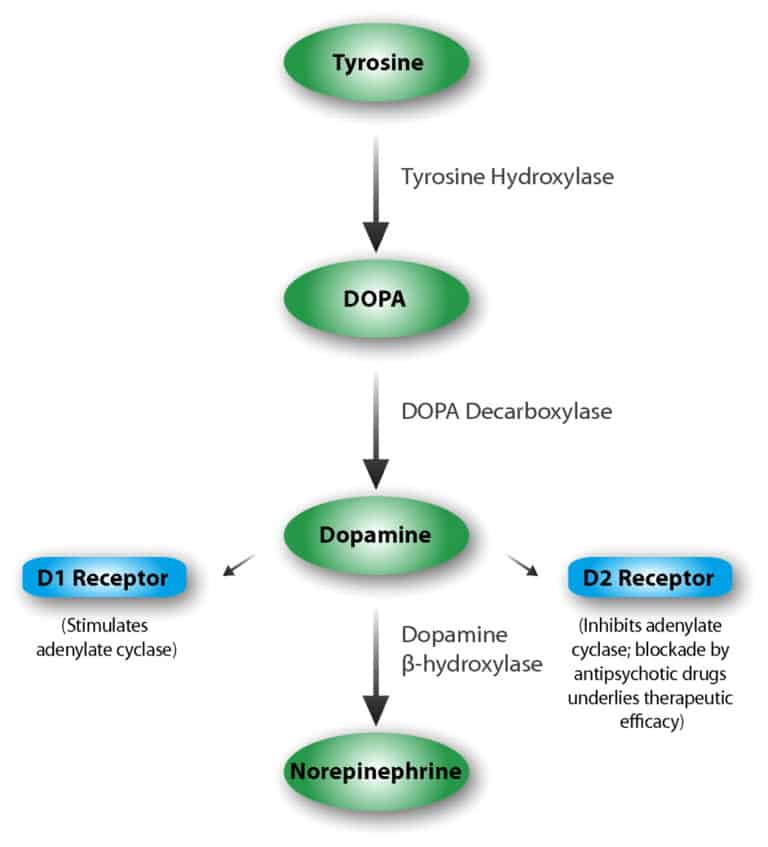
Source: Snyder S. What dopamine does in the brain. (2011)
Tyrosine can be found in animal sources
- meat (beef, pork)
- poultry (chicken, turkey, goose)
- fish (salmon, tuna, grouper)
- dairy (milk, cheese, yogurt)
and non-animal sources such as
- avocados
- bananas
- nuts (peanuts, almonds)
- soy products (tofu, tempeh and soymilk).[33]
Conditional amino acids
Conditional amino acids are amino acids that are not usually considered essential except in times of illness and stress.
We have listed all the conditional amino acids and included specific circumstances when they might be needed in additional quantities.
Arginine
Those who have experienced burns or wounds will require additional arginine. Also, individuals who have certain catabolic conditions may require additional supplementation. This includes preterm infants who are unable to create their own arginine.[34]
Cysteine
Cysteine is conditionally essential in infants, older adults and people who have metabolic or malabsorption syndromes.[35]
Glutamine
Glutamine is conditionally essential under stress conditions such as infection, injury and weaning.[35]
Tyrosine
Tyrosine is considered conditionally essential when the body is unable to produce enough tyrosine to meet the needs. This occurs when a deficiency in phenylalanine or amino acid disorder phenylketonuria is present.[35]
Glycine
The body’s ability to produce glycine may be compromised during times of illness, stress or injury.[34]
Proline
Under normal conditions glutamic acid synthesizes proline but under extreme stress such as burns, severe illness or even endurance exercise, proline can be considered conditionally essential.[35]
Serine
Serine is considered conditionally essential when there is an amino acid metabolism disorder present which means that the body can not produce serine on its own.[34]
Related Questions
1. How many amino acids are there?
There are 22 amino acids found in proteins. However, only 20 of those amino acids are specified in the universal genetic code that makes up our genes.[36]
2. What are aromatic amino acids?
Aromatic amino acids, much like proteinogenic amino acids, are the building blocks of proteins.
Aromatic amino acids include phenylalanine, tryptophan and tyrosine. These types of amino acids act as precursors for many biological and neurological processes.[37]
3. What are brain-chain amino acids (BCAA)?
Branch-chain amino acids are essential amino acids that have protein anabolic properties such as building tissues and organs.
These amino acids are
- valine
- leucine
- isoleucine.[38]
4. What is amino acid toxicity?
Amino acid toxicity is due to large intakes of amino acids which can produce issues in the body.
Amino acid toxicity is rare when consuming a well-balanced diet and most likely occurs during over supplementation.[38]
There are also non-protein amino acids that can be metabolized and be toxic in humans. For example, the Lathyrus species has an oxalyl-amino acid that is harmful to humans.[39]
5. What is the most common amino acid disorder?
The most common amino acid disorder relates to conditions that involve the metabolism of branched-chain amino acids.
Phenylketonuria and maple syrup urine disease is included in this group.[40]
We hope that you liked the article, and we have several more articles on amino acids coming up. If you would like to know when they will go live, we suggest Subscribing to our newsletter, and we’ll let you know well in advance.
Tiana is an Associate Registered Nutritionist who has a passion for public health and education. Working towards a Master’s in Nutrition Practice with a Bachelor’s in Human Nutrition, Tiana has a personal interest in healthy heart nutrition and promoting positive lifestyle behaviours.
Tiana is a part of the Content Team that brings you the latest research at D’Connect.
References
(1) Amino Acid: Benefits & Food Sources [Internet]. Cleveland Clinic. 2021 [cited 2022 Nov 24]. Available from: https://my.clevelandclinic.org/health/articles/22243-amino-acids
(2) Lopez MJ, Mohiuddin SS. Biochemistry, Essential Amino Acids [Internet]. Nih.gov. StatPearls Publishing; 2022 [cited 2022 Nov 24]. Available from: https://www.ncbi.nlm.nih.gov/books/NBK557845/
(3) Rees M. What to know about phenylalanine [Internet]. Medicalnewstoday.com. Medical News Today; 2021 [cited 2022 Nov 26]. Available from: https://www.medicalnewstoday.com/articles/phenylalanine
(4) Valine – Health Encyclopedia – University of Rochester Medical Center [Internet]. Rochester.edu. 2022 [cited 2022 Nov 26]. Available from: https://www.urmc.rochester.edu/encyclopedia/content.aspx?contenttypeid=19&contentid=Valine#:~:text=Valine%20is%20found%20mainly%20in,%2C%20vegetables%2C%20and%20whole%20grains.
(5) Tryptophan: MedlinePlus Medical Encyclopedia [Internet]. Medlineplus.gov. 2019 [cited 2022 Nov 26]. Available from: https://medlineplus.gov/ency/article/002332.htm#:~:text=Tryptophan%20is%20an%20amino%20acid,get%20it%20from%20your%20diet.
(6) PubChem. L-threonine [Internet]. @pubchem. PubChem; 2022 [cited 2022 Nov 26]. Available from: https://pubchem.ncbi.nlm.nih.gov/compound/L-threonine
(7) Liu L. 9 Essential Amino Acids | Food Sources to Find Them [Internet]. Foodunfolded.com. 2020 [cited 2022 Nov 26]. Available from: https://www.foodunfolded.com/article/9-essential-amino-acids-food-sources-to-find-them#:~:text=Animal%20sources%20of%20threonine%20include,of%20your%20recommended%20dietary%20intake.&text=Plant%20based%20sources%20include%20tofu,almonds%2C%20lentils%2C%20and%20pistachios.
(8) Methionine – Health Encyclopedia – University of Rochester Medical Center [Internet]. Rochester.edu. 2022 [cited 2022 Dec 23]. Available from: https://www.urmc.rochester.edu/encyclopedia/content.aspx?contenttypeid=19&contentid=Methionine#:~:text=Methionine%20is%20an%20antioxidant.,liver%20damage%20from%20acetaminophen%20poisoning
(9) PubChem. Histidine [Internet]. @pubchem. PubChem; 2022 [cited 2022 Nov 26]. Available from: https://pubchem.ncbi.nlm.nih.gov/compound/L-histidine
(10) PubChem. Leucine [Internet]. @pubchem. PubChem; 2022 [cited 2022 Nov 26]. Available from: https://pubchem.ncbi.nlm.nih.gov/compound/Leucine
(11) PubChem. Lysine [Internet]. @pubchem. PubChem; 2022 [cited 2022 Nov 26]. Available from: https://pubchem.ncbi.nlm.nih.gov/compound/L-lysine
(12) Alanine – Health Encyclopedia – University of Rochester Medical Center [Internet]. Rochester.edu. 2022 [cited 2022 Nov 27]. Available from: https://www.urmc.rochester.edu/encyclopedia/content.aspx?contenttypeid=19&contentid=Alanine#:~:text=Alanine%20is%20an%20amino%20acid,helps%20the%20body%20use%20sugars.
(13) List of foods high in alanine[Internet]. Botanical online. Botanical-online; 2019 [cited 2022 Dec 23]. Available from: https://www.botanical-online.com/en/food/alanine-rich-foods
(14) Karen Steward PhD. Essential Amino Acids: Chart, Abbreviations and Structure [Internet]. Applied Sciences from Technology Networks. Technology Networks; 2019 [cited 2022 Nov 26]. Available from: https://www.technologynetworks.com/applied-sciences/articles/essential-amino-acids-chart-abbreviations-and-structure-324357
(15) PubChem. Asparagine [Internet]. @pubchem. PubChem; 2022 [cited 2022 Nov 27]. Available from: https://pubchem.ncbi.nlm.nih.gov/compound/Asparagine#:~:text=Asparagine%20is%20a%20non%2Dessential,be%20eliminated%20from%20the%20body.
(16) Diet & the Spread of Breast Cancer. Oncology Times [Internet]. 2018 Mar [cited 2022 Nov 27];40(5):8. Available from: https://journals.lww.com/oncology-times/fulltext/2018/03050/diet___the_spread_of_breast_cancer.4.aspx#:~:text=Foods%20rich%20in%20asparagine%20include,include%20most%20fruits%20and%20vegetables.
(17) PubChem. Aspartic acid [Internet]. PubChem; 2022 [cited 2022 Nov 27]. Available from: https://pubchem.ncbi.nlm.nih.gov/compound/Aspartic-acid
(18) Kloss K. 7 Foods High in D-Aspartic Acid for Plant-Based and Meat-Eaters Alike [Internet]. LIVESTRONG.COM. Livestrong.com; 2011 [cited 2022 Nov 27]. Available from: https://www.livestrong.com/article/518754-foods-high-in-d-aspartic-acid/
(19) Cysteine – Health Encyclopedia – University of Rochester Medical Center [Internet]. Rochester.edu. 2022 [cited 2022 Dec 23]. Available from: https://www.urmc.rochester.edu/encyclopedia/content.aspx?contenttypeid=19&contentid=Cysteine#:~:text=Cysteine%20is%20a%20non%2Dessential,is%20important%20for%20making%20collagen
(20) Cysteine Information | Mount Sinai – New York [Internet]. Mount Sinai Health System. 2013 [cited 2022 Nov 27]. Available from: https://www.mountsinai.org/health-library/supplement/cysteine#:~:text=Cysteine%20is%20an%20amino%20acid,into%20glutathione%2C%20a%20powerful%20antioxidant.
(21) Glutamic Acid – Health Encyclopedia – University of Rochester Medical Center [Internet]. Rochester.edu. 2022 [cited 2022 Nov 27]. Available from: https://www.urmc.rochester.edu/encyclopedia/content.aspx?contenttypeid=19&contentid=GlutamicAcid#:~:text=Glutamic%20acid%20is%20an%20amino,involved%20in%20learning%20and%20memory.
(22) Medicover Hospitals. Glutamic acid | Medicine [Internet]. Medicoverhospitals.in. 2020 [cited 2022 Dec 23]. Available from: https://www.medicoverhospitals.in/medicine/glutamic-acid#uses
(23) Kumar P, Kraal AZ, Prawdzik AM, Ringold AE, Ellingrod V. Dietary Glutamic Acid, Obesity, and Depressive Symptoms in Patients With Schizophrenia. Frontiers in Psychiatry [Internet]. 2021 Jan 21 [cited 2022 Nov 27];11. Available from: https://www.frontiersin.org/articles/10.3389/fpsyt.2020.620097/full#:~:text=In%20a%20healthy%20diet%2C%20most,few%20high%20protein%20vegetable%20sources.
(24) Natural glutamic acid | Yeast Extract [Internet]. Yeast Extract. 2020 [cited 2022 Dec 23]. Available from: https://yeastextract.info/about-yeast-extract/for-professionals/natural-glutamate/
(25) Glutamine Information | Mount Sinai – New York [Internet]. Mount Sinai Health System. 2013 [cited 2022 Nov 27]. Available from: https://www.mountsinai.org/health-library/supplement/glutamine
(26) PubChem. Glycine [Internet]. @pubchem. PubChem; 2022 [cited 2022 Nov 27]. Available from: https://pubchem.ncbi.nlm.nih.gov/compound/Glycine
(27) Van G. Top 9 Benefits and Uses of Glycine [Internet]. Healthline. Healthline Media; 2018 [cited 2022 Dec 23]. Available from: https://www.healthline.com/nutrition/glycine#TOC_TITLE_HDR_
(28) Myhre, J. & Sifris, D. What Is Glycine? [Internet]. Verywell Health. 2019 [cited 2022 Nov 27]. Available from: https://www.verywellhealth.com/glycine-overview-4583816
(29) PubChem. Proline [Internet]. PubChem; 2022 [cited 2022 Nov 27]. Available from: https://pubchem.ncbi.nlm.nih.gov/compound/Proline
(30) Botanical-Online. List of foods high in Proline [Internet]. Botanical online. Botanical-online; 2019 [cited 2022 Nov 27]. Available from: https://www.botanical-online.com/en/food/proline-rich-foods
(31) Serine: Uses, Interactions, Mechanism of Action | DrugBank Online [Internet]. Drugbank.com. DrugBank; 2017 [cited 2022 Nov 27]. Available from: https://go.drugbank.com/drugs/DB00133
(32) Kapalka GM. Depression. Nutritional and Herbal Therapies for Children and Adolescents [Internet]. 2010 [cited 2022 Nov 27];141–87. Available from: https://www.sciencedirect.com/science/article/pii/B9780123749277000066
(33) Tyrosine Information [Internet]. Mount Sinai Health System. 2013 [cited 2022 Nov 27]. Available from: https://www.mountsinai.org/health-library/supplement/tyrosine#:~:text=Tyrosine%20is%20a%20nonessential%20amino,epinephrine%2C%20norepinephrine%2C%20and%20dopamine.
(34) Amino Acids – Essential, Nonessential, Conditional | Oxford Compounding [Internet]. Oxford Compounding. 2019 [cited 2022 Nov 26]. Available from: https://www.oxfordcompounding.com.au/amino-acids/
(35) Amino Science. The Low-Down on Conditionally Essential Amino Acids [Internet]. The Amino Company. The Amino Company; 2018 [cited 2022 Dec 23]. Available from: https://aminoco.com/blogs/amino-acids/conditionally-essential-amino-acids
(36) Structure & Function – Amino Acids [Internet]. Biology LibreTexts. 2017 [cited 2022 Dec 23]. Available from: https://bio.libretexts.org/Bookshelves/Biochemistry/Book%3A_Biochemistry_Free_For_All_(Ahern_Rajagopal_and_Tan)/02%3A_Structure_and_Function/202%3A_Structure__Function_-_Amino_Acids
(37) Han Q, Phillips RS, Li J. Aromatic amino acid metabolism. Frontiers in molecular biosciences. 2019 Apr 10;6:22.
(38) Munro HM. Nutritional consequences of excess amino acid intake. Adv Exp Med Biol. 1978;105:119-29. doi: 10.1007/978-1-4684-3366-1_8. PMID: 103372.
(39) Nunn PB, Bell EA, Watson AA, Nash RJ. Toxicity of non-protein amino acids to humans and domestic animals. Nat Prod Commun. 2010 Mar;5(3):485-504. PMID: 20420333
(40) Amino Acid Metabolism Disorders [Internet]. Medlineplus.gov. National Library of Medicine; 2016 [cited 2022 Dec 23]. Available from: https://medlineplus.gov/aminoacidmetabolismdisorders.html



